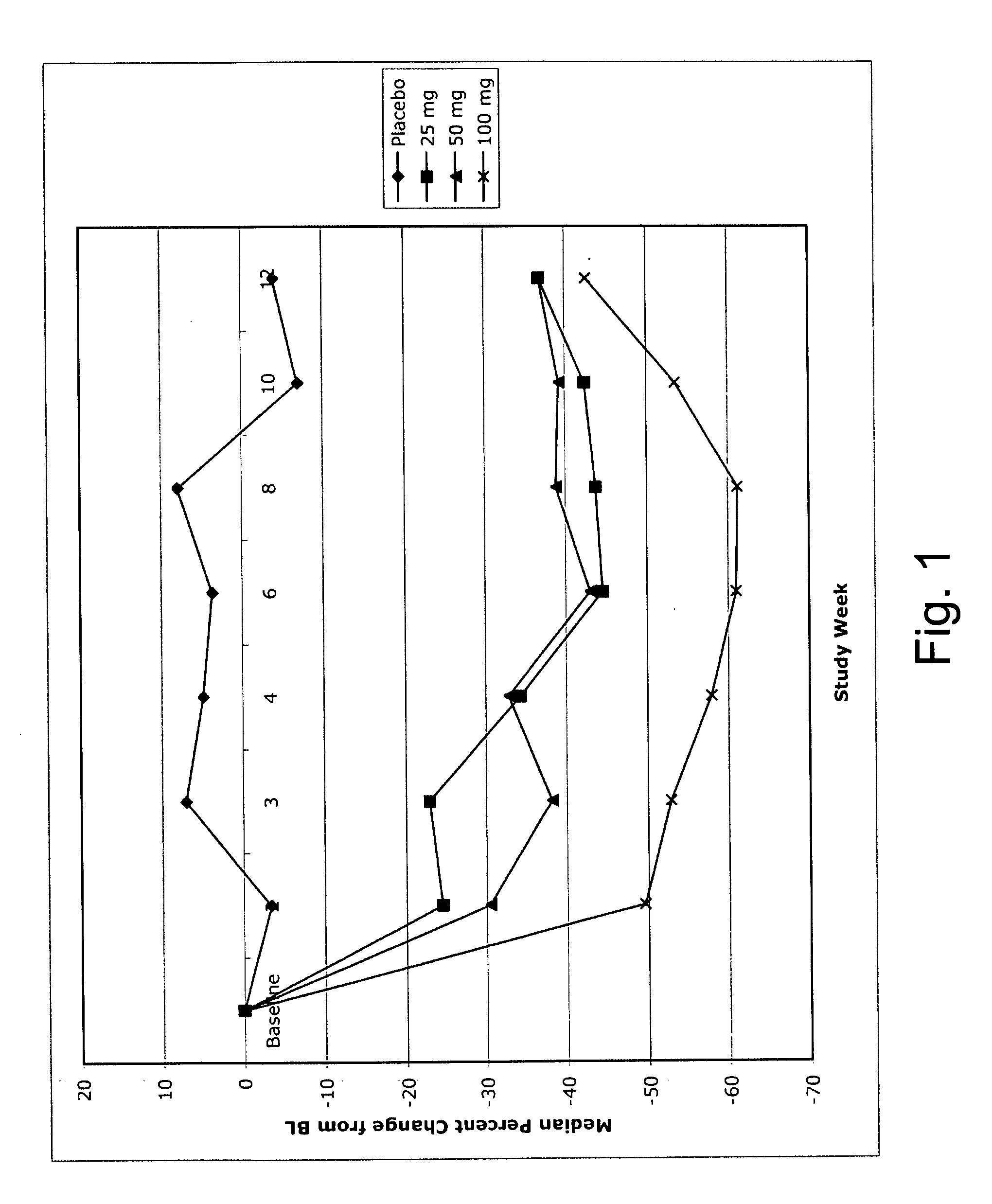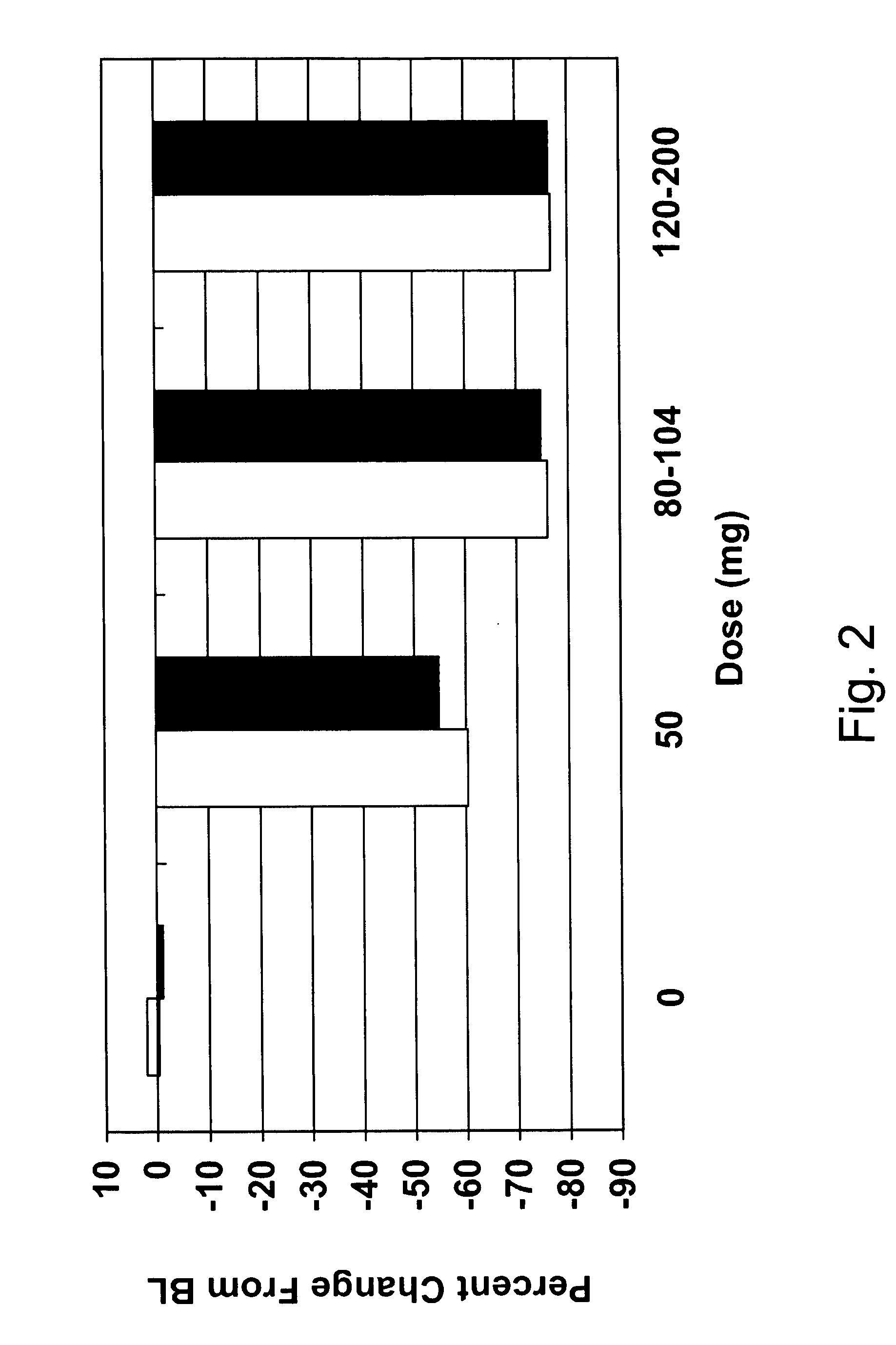Methods of using IL-1 antagonists to reduce C-reactive protein
a technology of c-reactive protein and il-1 antagonist, which is applied in the direction of angiogenin, drug composition, metabolism disorder, etc., can solve the problems of medical care and hospitalization, and achieve the effects of reducing the risk of development, reducing the risk of crp, and reducing alcohol intak
- Summary
- Abstract
- Description
- Claims
- Application Information
AI Technical Summary
Benefits of technology
Problems solved by technology
Method used
Image
Examples
example 1
A Randomized, Double-Blind, Placebo-Controlled Dose Ranging Study of IL-1 trap in Patients with Active Rheumatoid Arthritis
[0056] A study was conducted to compare weekly subcutaneous doses of 25, 50, and 100 mg of the IL-1 antagonist of SEQ ID NO:2 (“IL-1 trap”) with placebo in 201 patients with rheumatoid arthritis (RA), of which 114 (56.7%) completed the study. At baseline, patients were required to have a CRP level greater than 3.0 mg / L (0.3 mg / dL). CRP levels were measured at weeks 2, 3, 4, 6, 8, 10, and 12. The C-reactive protein assay was performed by immunonephelometry (Dade Behring nephelometer). Polystyrene particles coated with monoclonal antibodies to CRP were agglutinated when mixed with samples containing CRP. The intensity of the scattered light in the nephelometer depends on the CRP content of the sample and the CRP concentrations are determined versus dilutions of a standard of a known concentration.
[0057] Eligible patients were males or females between 18 and 75 y...
example 2
Effect of Two Formulations of IL-1 Trap on Serum CRP levels in Volunteers
[0059] Study design. A study was conducted to determine the effect on serum CRP of two formulations of IL-1 trap injected in a range of volumes subcutaneously to normal volunteers. A six-week, double blind, placebo-controlled, single dose, single center study with four sequential dose groups: Group A: 1:1:1:1:1:1 balanced random allocation; Group B: A single two-injection dose (1.5 mL per injection); Group C: A single two-injection dose (2.0 mL per injection); and Group D: A single two-injection dose (2.0 mL per injection). There were 12 subjects in each of 6 treatment groups, for a total of 72 subjects in Group A, a total of 7 subjects in Group B, 14 subjects in Group C, and 7 subjects in Group D.
[0060] Inclusion requirements. Normal volunteers aged 18-70 with no known significant concomitant illness and no concomitant medication use except as-needed analgesics (at protocol specified times) and / or oral contr...
example 3
Effect of IL-1 Trap on Serum CRP on Adults with Autoinflammatory Disease
[0063] In this study, IL-1 trap was administered as a 3 100 mg subcutaneous doses given in 3 consecutive days (days 1-3) to subjects with clinically active autoinflammatory disorders, including the CIAS1-associated disorders, FMF, and adult-onset Still's disease. CRP (mg / dL) was measured as described above on one or more of days 0-29 after administration of the trap. Baseline values for CRP and CRP levels four days after the last 100 mg dose are shown in Table 2. Significant decreases in CRP levels were achieved within four days of administration.
TABLE 2Effect of IL-1 Trap on CRP levels in Subjectswith Autoinflammatory DiseaseCRP (mg / dL)SubjectBaselineDay 413.180.6828.591.333.380.10
PUM
| Property | Measurement | Unit |
|---|---|---|
| Fraction | aaaaa | aaaaa |
| Density | aaaaa | aaaaa |
| Time | aaaaa | aaaaa |
Abstract
Description
Claims
Application Information
 Login to View More
Login to View More - R&D
- Intellectual Property
- Life Sciences
- Materials
- Tech Scout
- Unparalleled Data Quality
- Higher Quality Content
- 60% Fewer Hallucinations
Browse by: Latest US Patents, China's latest patents, Technical Efficacy Thesaurus, Application Domain, Technology Topic, Popular Technical Reports.
© 2025 PatSnap. All rights reserved.Legal|Privacy policy|Modern Slavery Act Transparency Statement|Sitemap|About US| Contact US: help@patsnap.com


